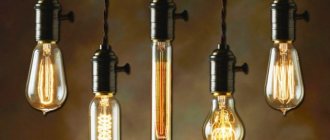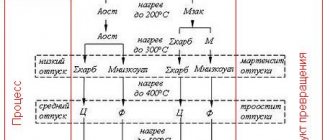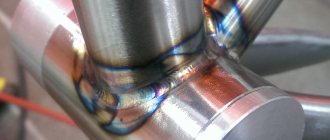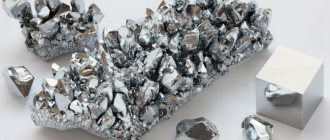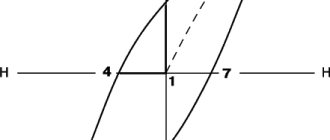Titanium VT1-0 is one of the most popular brands on the Russian rolled metal market. Almost everything is made from it: pipes, sheets, rods, squares and other products. All thanks to its physical and chemical properties. It is lightweight, durable, can withstand exposure to aggressive environments, is non-magnetic, and has a beautiful appearance. An almost ideal metal that helps solve many problems in the national economy and the defense industry!
The decoding VT1-0 means that this brand was developed by the All-Russian Scientific Research Institute of Aviation Materials VIAM (the letter “B” in the marking). The letter "T" stands for the actual metal itself. Then follow the numbers 1-0 which indicate the serial number of the alloy. It should be noted that this marking is purely Russian and is not used abroad. That is, when purchasing metal or products made from it from foreign suppliers, it is necessary to find appropriate foreign analogues. The list of analogues is given below in the text.
Color marking : some types of rolled metal are marked with paint for greater clarity. In the case of the 1-0 brand, its color is “white”. For example, you can find rods whose ends are painted white. This means that they are made from this brand. Please note that not all types of rolled metal are color coded.
Chemical composition
Titanium grade VT1-0 is called technical and does not contain alloying elements. The mass fraction of titanium itself is quite high and is about 99.2 - 99.7%. The rest is made up of iron, carbon, silicon, oxygen and hydrogen.
The document that establishes the permissible ratio of metal and impurities in it is GOST 19807-91 Titanium and wrought titanium alloys. Stamps. It establishes the chemical composition of the metal for almost all rolled products. It states that the VT1-0 grade should contain no more than 0.1% silicon and 0.25% iron. No more than 0.7% aluminum is allowed.
Compared to VT1-00, the brand has a higher amount of impurities. That is, the VT1-00 brand is the purest of all possible. W1-0 follows immediately after it.
Thermal conductivity
The thermal conductivity of aluminum is one of its physical parameters. It, like almost everything, depends on the purity of the material structure. In other words, the closer the purity of aluminum is to unity, the higher its thermal conductivity characteristics. Technical aluminum, the percentage of which is approximately 99.49, has a thermal conductivity (at 200 degrees Celsius) of 209 W/(m*K). If technical aluminum has a percentage of 99.70, then the value of its thermal conductivity reaches 222 W/(m*K).
At a time when the material is electrolytically refined and its purity is 99.9%, the thermal conductivity value already at 190 degrees Celsius increases to 343 W/(m*K). Unlike strength, which increases when aluminum is alloyed with other alloys, thermal conductivity characteristics in this case decrease. An example is the addition of Mn. Just two percent of such an additive can reduce the thermal conductivity of aluminum from a value of 209 W/(m*K) to a value equal to 126 W/(m*K). It is also worth noting that the thermal conductivity characteristics of aluminum are so high that only copper and silver have an advantage over them.
The melting point of aluminum is a fairly significant indicator that is taken into account by any industry that works with this material. The melting point is an unstable indicator; in almost everything it depends on what materials are used for admixture with aluminum. The melting temperature determines the processing speed of the material, in other words, one might say, production capabilities. More often, aluminum is processed in Russia, Australia, Canada and the USA (the United States of America is a country in North America)
. In these countries, a large share of the industry is engaged in aluminum smelting.
Each country has its own smelting technologies, over time, thanks to tests with the addition of different materials, which have allowed the melting point of aluminum to decrease slightly. A more precise, common indicator of the melting point of aluminum is 660.32 degrees Celsius. Due to such a huge indicator, the melting of the material can only be organized under special conditions and specially equipped rooms. To perform this process at home, the first thing you need is equipment. Typically a crucible muffle furnace is used for this.
Mechanical properties
| Assortment | Size, mm. | Short-term strength limit, MPa | Elongation at break, % | Relative narrowing, % | Impact strength, kJ/m2 | Heat treatment |
| Sheet, GOST 22178-76 | 375 | 20-30 | ||||
| Pipes, GOST 24890-81 | 390-590 | 15 | ||||
| Annealed rod, GOST 26492-85 | 345 | 15 | 36-40 | 500-700 | ||
| Bar, increased quality, GOST 26492-85 | 355-540 | 19-20 | 38-50 | 500-1000 | Annealing | |
| Plate, GOST 23755-79 | 11-60 | 370-570 | 13 | 27 | ||
| Plate, GOST 23755-79 | 60 — 150 | 295-540 | 10 | 24 |
Advantages
- The metal has a density of 4505 kg per cubic meter. That is, the weight of one cubic meter of metal will be only 4.5 tons! This is almost half the weight of a similar volume of stainless steel metal! For comparison, the density of the most popular grade of stainless steel 12Х18Н10Т is 7920 kg/m3.
- Titanium VT1-0 has high strength, but is also ductile and tough. However, its low thermal strength makes it less suitable for the aviation industry than special alloys developed specifically for these purposes.
- Has a low coefficient of thermal expansion. Simply put, it expands slightly and contracts slightly when exposed to heat and cold. This property significantly reduces the wear of products.
- The metal has excellent chemical resistance and resistance to aggressive environments. It is resistant to oxidation due to the fact that a strong oxide film is formed on the surface, which prevents deep oxidation. Resistant to acids and chlorine! Among all others, pipes made of this metal are best suited for transporting liquid chlorine.
- The metal has a high melting point: about 1668 degrees Celsius. This makes it possible to use it at very high temperatures.
- Does not react to magnetic fields and is not magnetized. At the same time, it is not pushed out of the field, like copper, for example. A remarkable property for instrument making.
What does this mean for the consumer? First of all, this is a reduction in the weight of all titanium products compared to similar products made of stainless steel or ferrous metal. This undeniable advantage, along with the highest strength, served as the main arguments for the use of this metal in many important industries, such as the aviation and space industries.
Resistance to corrosion and acids makes rolled titanium indispensable in food production, the chemical industry and other similar industries.
Flaws
- They learned to extract pure metal with a small amount of foreign impurities relatively recently. For this they use the most advanced technologies, and this could not but affect the price.
- In addition, the metal is very hard and its processing also requires relatively more energy and appropriate equipment.
- When melted, the metal becomes very active and begins to combine with various gases in the atmosphere. For this reason, it has to be melted in a vacuum or in a special inert environment.
All of these shortcomings directly affect the cost of the final rolled metal products. It is the high price that is the factor that prevents the widespread replacement of stainless steel products with titanium VT1. It is very difficult to mine, smelt and process.
Types of alloys
Titanium alloys can be divided into three large groups:
- Compounds based on chemical compounds. Representatives of this group have a heat-resistant structure and low density. A decrease in density directly affects a decrease in the weight of the material. Such alloys are used in the manufacture of parts for cars, frames for aircraft and hulls for ships.
- Heat-resistant alloys with low density. This is an analogue of compounds with nickel, but at a lower price. Depending on the chemical composition, the resistance of the titanium alloy to high temperatures varies.
- Structural - high-strength connections that are easy to process due to their high ductility. These alloys are used to make parts that are installed in equipment that operates under heavy loads.
When producing titanium alloys, official markings are used that indicate what metals it is combined with.
Analogues of the VT1-0 brand
As noted earlier, markings with two letters and a digital designation are purely Russian and are not used in other countries. Therefore, when buying abroad, it is important to know which foreign brands correspond to domestic ones.
- In the United States of America the equivalent is Grade 2
- In Germany - DIN 7034 , DIN 3.7035, DIN Ti2
- In Japan - JIS CI2
- In France - AFNOR T-40
- In England -IMI125
It should be taken into account that these analogues may differ in composition from domestic titanium and are closest to it. Therefore, when purchasing from abroad, it is best to find a company in Russia that has the necessary certificates of conformity for foreign products.
Buyers often wonder whether it is possible to replace domestically produced VT1-0 titanium with one made in China or another country. Answer: yes, you can. In case foreign rolled metal products have certificates of conformity and chemical composition tests. Rolled metal products manufactured abroad can fully replace domestic ones. However, when it comes to such serious industries as defense, then replacement is not practiced here.
Material Density
The density of aluminum is the expression of the mass of the material in terms of content per unit size. Density is also called the limit of the mass of a substance in relation to the size occupied by this substance. It is using this formula that the density of a light alloy of special purity is calculated. Its indicator is 2.7 * 10 cubed kg/m3. Density is a property on which another feature of the material depends, namely strength. Because the density of the light alloy is quite low, the strength is correspondingly low. Therefore, aluminum is not used as a design material.
To increase the strength of the alloy, other elements with the highest density are added to it. Under the influence of the most dense additives, the strength of aluminum increases sharply. Also, strength characteristics can be increased by introducing mechanical or heat treatment. As a result of successful combination in alloys, aluminum acquires valuable structural properties, expressed in good mechanical strength with a low material density. Aluminum-based alloys in some industries are successfully replacing alloys (alloys) such as copper or tin, zinc or lead.
Areas of use
The bulk of titanium is spent on the needs of aviation and rocket technology and marine shipbuilding. It, as well as ferrotitanium, is used as an alloying additive to high-quality steels and as a deoxidizing agent. Technical titanium is used for the manufacture of containers, chemical reactors, pipelines, fittings, pumps, valves and other products operating in aggressive environments. Compact titanium is used to make meshes and other parts of electric vacuum devices operating at high temperatures.
Heat capacity
The heat capacity of aluminum, if we take the indicator of constant pressure and temperature 291, will be 581 cal/degree, mol. But the heat capacity of the material can change significantly if the temperature value is low. The highest heat capacity dictates the conditions regarding the use of fairly massive heat sources. From time to time he even uses a heating method. The height of the linear expansion coefficient level, as well as an insignificant elastic modulus, can cause significant welding deformations. Such an event dictates the conditions for using clamping devices with an increased level of reliability.
The resulting deformations in systems, which should be approached responsibly, are eliminated after welding. It should be noted that the highest characteristics of such parameters as heat capacity and thermal conductivity, relative to aluminum itself, as well as its alloys, significantly influence which specific welding method should be chosen. The specific heat capacity of aluminum, measured in J/(kg * degrees Celsius), is equal to the value 920. If we take the characteristics of the specific heat capacity, it should be noted that they vary depending on the state of aggregation of the material.
Interesting read: How to make an aluminum boat with your own hands
Physical properties and characteristics of one of the hardest metals - titanium
Titan is an element of group 4 of period 4. A transition alloy, exhibits both main and acidic characteristics, and is quite widespread in nature - 10 space. More interesting for the national economy is the combination of the highest hardness of the alloy and lightness, which makes it an indispensable element for aircraft construction. This article will tell you about the markings, alloying and other properties of titanium alloy, give a general description and noteworthy facts about it.
Resistivity
The resistivity of aluminum is higher compared to the same value of copper. But the resistivity of copper can be significantly affected by processing methods such as annealing. This method has virtually no effect on aluminum. With all this, the temperature coefficients of copper and aluminum are similar. Oxide insulation is often used in the cable industry.
The heat resistance of oxidized duralumin wire is 400 degrees Celsius. Absolutely, the resistivity of the material in question exceeds that of copper by 1.65 times. Duralumin wires are quite often subjected to oxide insulation. At the same time, in order to apply this method to a copper wire, it must be coated with at least a thin layer of aluminum. Oxidized aluminum serves as a material for the production of coils that can operate at high temperatures.
Chemical characteristics
The chemical characteristics of aluminum express its valence and characteristics of interaction with surrounding spheres. The first thing that needs to be noted is that aluminum has fairly high chemical activity. If we look at the range of voltages of metals, then this material will occupy the space between magnesium and zinc. Aluminum is characterized by rapid oxidation by oxygen taken from the air, resulting in a strong protective oxide film.
This particular film is an obstacle to the upcoming oxidation of the material. Also, the oxide film protects aluminum products from interaction with other substances, contact with which can lead to destruction of the structure of the material. It is the protective film that plays the role of a factor that increases the anti-corrosion resistance of aluminum. If this oxide protection is violated, the material simply interacts with moisture even at ordinary temperatures.

